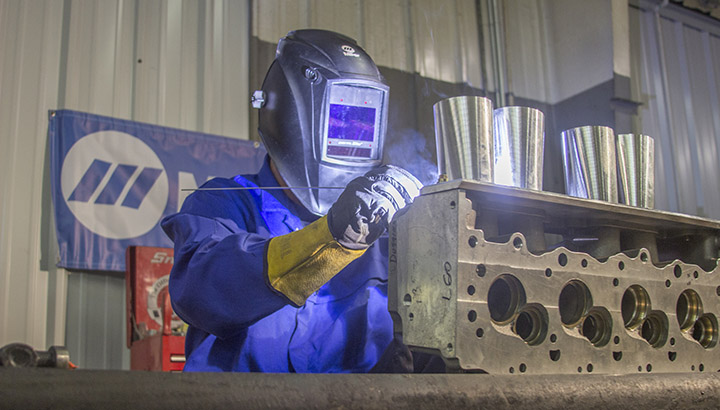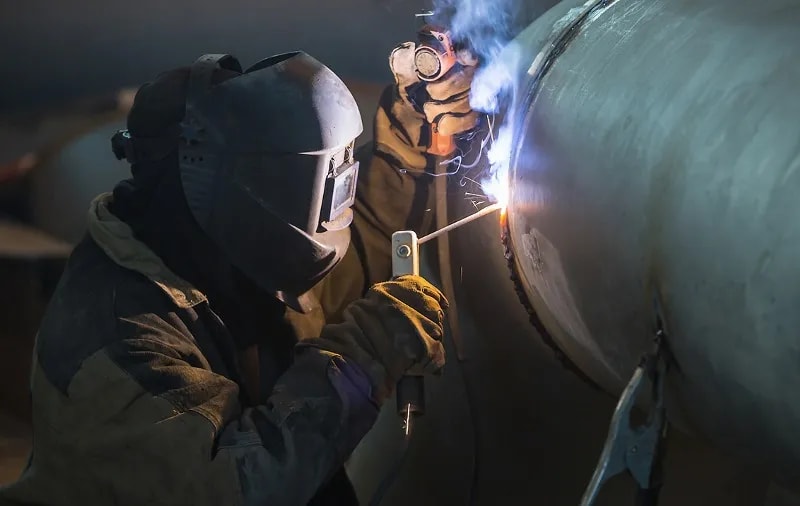Reliable weld inspection practices shared by Montana Mobile Welding and Repair
Usual Welding Repair Service Issues and Just How to Address Them Efficiently
Welding fixings typically run into a series of concerns that can jeopardize the integrity of the final item. Typical issues consist of insufficient infiltration, porosity, and misalignment, amongst others. Each flaw provides special obstacles that call for specific strategies for resolution. Recognizing these issues is essential for welders aiming to enhance their end results and abilities. This discussion will explore these common welding repair service problems and reliable methods to address them.
Inadequate Infiltration
Poor infiltration happens when the weld metal stops working to fully fuse with the base product, leading to weak joints and potential architectural failings. This concern usually originates from insufficient warmth input, inaccurate electrode angle, or improper welding rate. Welders might experience insufficient penetration because of a miscalculation of the necessary criteria for a certain material density or kind. Additionally, contamination on the base product's surface can impede effective bonding, intensifying the trouble. To resolve insufficient infiltration, welders ought to ensure suitable settings on their devices and preserve a tidy job surface area. Normal examination of welds is advised to identify any kind of deficiencies early, permitting for timely improvements and the avoidance of compromised structural stability in welded assemblies.
Porosity
Porosity is a typical defect in welded joints that manifests as small gas bubbles entraped within the weld steel. This problem can endanger the integrity of the weld, bring about decreased toughness and prospective failure under stress and anxiety. Welding. Porosity generally arises from contamination, dampness, or improper welding strategies, which permit gases to get away into the molten weld swimming pool. To address porosity, welders should ensure appropriate surface area prep work, keep a tidy workplace, and use suitable welding specifications. Furthermore, selecting the right filler material and shielding gas can mitigate gas entrapment. Normal inspection and screening of welds can aid identify porosity early, guaranteeing timely restorative actions are taken, consequently maintaining the high quality and dependability of the bonded framework
Imbalance
Misalignment in welding can emerge from numerous factors, including inappropriate setup and thermal expansion. Understanding the origin is vital for efficient resolution. A number of modification methods are offered to realign components and assure structural stability.
Reasons of Imbalance
Welding imbalance usually stems from a selection of underlying problems that can endanger structural integrity. One key cause is inappropriate fit-up of parts prior to welding, which can result in spaces and unequal surface areas. Variants in thermal expansion during the welding procedure can also lead to distortion, especially if the products being joined have various coefficients of development. Furthermore, poor securing and fixturing might fall short to hold parts securely in place, leading to movement throughout welding. Inadequately kept equipment, including welding devices and tools, might present variances in the weld grain, more contributing to misalignment. Finally, driver error, originating from inadequate training or experience, can likewise play a significant duty in developing misaligned welds.
Improvement Methods Available
Dealing with imbalance efficiently needs a combination of corrective methods tailored to the certain concerns available. One common method is using jigs or components to hold elements in the right setting during welding, guaranteeing constant positioning. In addition, pre-heating the materials can help in reducing distortion and enhance fit-up. For substantial misalignment, mechanical realignment methods, such as making use of hydraulic jacks or clamps, can be used to remedy the setting before welding. Post-weld warmth therapy might also be necessary to alleviate stress and anxieties triggered by imbalance. Finally, mindful assessment and adjustment during the setup stage can protect against misalignment problems from coming to be substantial problems, advertising a smoother welding procedure and boosting total architectural stability.
Distortion
Distortion is a common challenge in welding that can occur from different variables, including irregular cooling and heating. Understanding the reasons for distortion is important for carrying out reliable avoidance techniques. Resolving this concern not only boosts structural integrity however additionally enhances the total high quality of the weld.
Reasons of Distortion
When based on the extreme warmth of welding, products commonly undergo changes that can bring about distortion. This phenomenon mainly occurs from thermal growth and contraction during the welding process. As the weld location warms up, the material expands; upon cooling, it acquires, which can create inner tensions. Furthermore, irregular heating across a workpiece can exacerbate these anxieties, leading to bending or flexing. The kind of material also plays a considerable duty; metals with varying thermal conductivity and coefficients of development might respond in different ways, leading to uncertain distortions. Poor joint style and poor fixturing can add to imbalance throughout welding, increasing the possibility of distortion. Comprehending these causes is essential for reliable welding repair and avoidance methods.
Avoidance Techniques
Effective avoidance strategies for distortion during welding concentrate on regulating warm input and making sure proper joint layout. Maintaining a consistent heat input aids to decrease thermal development and tightening, which can bring about distortion. Making use of techniques such as preheating the work surface can additionally decrease the temperature slope, advertising consistent heating. In addition, selecting appropriate joint styles, such as T-joints or lap joints, can enhance security and minimize stress and anxiety focus. Executing appropriate fixturing to protect the work surfaces in location additionally help in preserving alignment during the welding procedure. Ultimately, staggered welding sequences can distribute warm much more evenly, avoiding localized distortion. By using these strategies, welders can significantly reduce the likelihood of distortion and enhance the total top quality of their welds.
Breaking
Breaking is a typical problem encountered in welding repair services, often resulting from numerous factors such as improper air conditioning rates, material choice, or poor joint preparation. The event of splits can greatly jeopardize the honesty of the weld, causing possible failings throughout operation. To address click here for info this issue, welders should first evaluate the origin, ensuring that materials work and suitably selected for the details application. Furthermore, controlling the cooling rate throughout the welding procedure is necessary; rapid air conditioning can induce stress and anxiety and lead to fracturing. Appropriate joint layout and prep work likewise add to reducing the threat. Executing these strategies can improve weld top quality and resilience, inevitably lowering the likelihood of splitting in ended up weldments.

Insufficient Blend
A substantial issue in welding repair services is incomplete fusion, which happens when the weld steel does not adequately bond with the base product or previous weld passes - Montana Mobile Welding and Repair Belgrade Welding. This flaw can bring about weak points in the joint, possibly compromising the honesty of the welded framework. Aspects adding to insufficient blend consist of inadequate warmth input, incorrect welding technique, and contamination of the surfaces being signed up with. To resolve this problem efficiently, welders ought to assure appropriate pre-weld cleaning and surface area preparation, in addition to readjust their welding parameters to accomplish sufficient penetration and blend. Normal inspection during the welding process can likewise help identify incomplete fusion early, enabling timely rehabilitative measures to enhance the general top quality of the weld
Overheating
While welding fixings can improve architectural stability, overheating provides a substantial obstacle that can bring about material degradation. Excessive warmth during welding my response can modify the mechanical homes of steels, leading to minimized stamina, increased brittleness, and warping. This phenomenon is especially important in high-stress applications where structural integrity is vital. Determining getting too hot can include visual inspections for discoloration or distortion, as well as keeping track of temperature level during the welding procedure. To minimize the risks connected with getting too hot, welders ought to employ appropriate methods, such as regulating warm input, adjusting traveling rate, and making use of ideal filler materials. Additionally, applying pre- and post-weld warm treatments can assist restore product buildings and enhance the total top quality of the fixing, guaranteeing long-term efficiency and security.
Often Asked Questions
What Are the Typical Indications of a Welding Defect?

Exactly How Can I Test My Welds for High quality?
To check welds for top quality, one can make use of visual assessments, ultrasonic screening, and radiographic techniques. Each technique assures structural honesty, determines flaws, and validates adherence to specified criteria, eventually improving the integrity of the welded joints.
What Security Precautions Should I Take While Welding?
When welding, one should focus on safety by wearing appropriate personal safety tools, ensuring appropriate air flow, securing flammable materials away, preserving a tidy work space, and understanding environments to avoid crashes and injuries.
Can I Repair a Weld Without Redesigning the Entire Joint?
Repairing a weld without redoing the entire joint is possible, depending upon the damage (Fabrication). Techniques such as grinding, including filler product, or using a welding procedure can successfully deal with details flaws while preserving the bordering framework
What Tools Are Vital for Reliable Welding Repairs?
Essential tools for effective welding repair services consist of a welding machine, wire brush, grinder, Read Full Report protective gear, clamps, and filler materials. Each tool plays a crucial function in making sure top quality and safety and security during the repair service procedure. Porosity usually emerges from contamination, dampness, or incorrect welding techniques, which enable gases to get away right into the liquified weld pool. Badly maintained devices, including welding equipments and devices, may introduce incongruities in the weld grain, additional contributing to misalignment. When subjected to the intense heat of welding, products commonly undergo adjustments that can lead to distortion. Breaking is a common concern run into in welding repair work, commonly resulting from different elements such as inappropriate cooling prices, material selection, or poor joint preparation. A substantial concern in welding repairs is insufficient fusion, which occurs when the weld metal does not properly bond with the base product or previous weld passes.